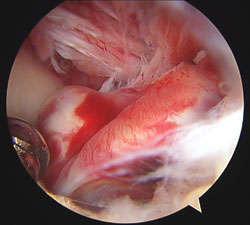Older age alone may not rule out ACL reconstruction, study reveals
A case control study comparing older and younger patients who underwent ACL reconstruction revealed no significant differences between the groups in terms of postoperative Lysholm scores and complications.
“Clinical outcomes after ACL reconstruction in patients over 40 are comparable to those of young patients, and we feel that age alone cannot be a sole exclusion criteria for ACL reconstruction in these older patients,” Albert O. Gee, MD, said in his study presentation at the 2011 Annual Meeting of the Arthroscopy Association of North America.
|
Images: Gee AO |
Identical procedure, rehabilitation
Gee and his colleagues retrospectively reviewed 45 patients older than 40 years of age who had an ACL reconstruction performed at their institution between 2000 and 2008. The investigators compared the group to a cohort of 48 patients younger than 25 years old who underwent ACL reconstruction during the same 5-year period. All of the patients had isolated ACL injuries.
All of the patients underwent arthroscopically-aided, single-incision, transtibial ACL reconstruction performed by three surgeons. The surgeons selected ACL grafts based on patient age and preference. Older patients had predominantly allograft reconstructions while younger patients had a mix of allografts and autografts.
|
|
Associated injuries in the older group included lateral and medial meniscus tears, collateral ligament sprains, articular cartilage degeneration and bone bruises. The younger group had similar injuries, and investigators found the same number of meniscal abnormalities in both groups at the time of surgery. However, Gee noted, there was a higher rate of articular cartilage injury and degeneration in the older group noted at the time of surgery.
Each patient underwent rehabilitation including early weight bearing and range of motion, and a graduated running program at 3 months postoperatively. Patients were prohibited from contact sports and pivoting activities for 6 months postoperatively. The patients had a minimum 2-year follow-up.
Similar results
The researchers found that despite the difference in age, both groups had low complication rates. Complications in the older group included one graft rupture, one repeat surgery for stiffness, one patient who underwent removal of a loose body and one patient who had an infection that was successfully treated with repeat incision, debridement and antibiotic treatment but did not undergo graft removal. The investigators noted three graft ruptures in the younger cohort.
The two groups were similar in terms of patient-reported outcomes. At an average of 5 years after surgery, both older and younger groups had good outcomes by Lysholm score (older and younger groups were 89.5 and 89.2, respectively). Study limitations, Gee noted, included different types of grafts used, multiple surgeons performing the procedures, lack of preoperative Lysholm scores and retrospective nature of the study.
“Lysholm scores after ACL reconstruction in patients over the age of 40 was equivalent to those in the younger patients,” Gee said. “Our findings, which are consistent with previous research in this area, show that patients over the age of 40 years of age should not be excluded from ACL reconstruction based on age alone.” – by Renee Blisard
Reference:
- Gee AO, Kinsella SD, Lee, GC, et al. ACL reconstruction in patients over 40 years of age: A case control study. Paper #SS-60. Presented at the 2011 Annual Meeting of the Arthroscopy Association of North America. April 14-16. San Francisco.

- Albert O. Gee, MD, can be reached at Department of Orthopaedic Sugery, University of Pennsylvania, 3400 Spruce Street, Philadelphia, PA 19104; 215-662-3350; email: albert.gee@uphs.upenn.edu.
- Disclosures: Gee and his co-authors have no relevant financial disclosures.


